Military ranks of the Philippines
The following list presents the ranks and insignia of the Armed Forces of the Philippines, one of Asia's oldest armed services.
Introduction
The current Philippine military ranks are inspired partially by the very first military insignia used by the military forces during the Philippine Revolution of 1896 and the Philippine–American War, and the insignia used by the Philippine Constabulary raised in 1902 during the final days of the Philippine–American War. The ranks used by these forces were designed by Americans under the tutelage of Captain Henry T. Allen, the "father of the Philippine Constabulary". The original Philippine military ranks are those actually worn by the Philippine Revolutionary Army, the nemesis of the Philippine Constabulary. The Philippine Constabulary is one of the predecessors of the present day Armed Forces of the Philippines. Elements of both the US army ranks and the old Philippine Army appear in the current ranks; this was reflected at the general officers insignia and enlisted ranks that resembled those of the US military (the silver stars used by generals and admirals were used by field grade officers in the First Republic), the field officers [like colonels], whose insignia are suns, use those insignia used by general officers of the Revolutionary Army. Company rank insignia[i.e. captain], consisting of a silver triangle, are a recent creation. Both company grade and field grade officer insignia have the baybayin letter ka ( K) in the middle, another throwback to the days of the war for independence, and even in the medal used by second-level members of the Katipunan during meetings, in which the letter is in the center.
Revolutionary Army ranks
These rank insignia for the nascent army were created in late 1896, replacing the earlier rank insignia used by the Katipuneros containing the letter K (ka). Ranks were then wore on the sleeves of all uniforms.
Officer ranks
| Revolutionary Army ranks | Tagalog Name | Spanish Name | Sleeve insignia |
|---|---|---|---|
| Minister Marshal | Ministrong Mariskal | Ministro Mariscal | |
| General | Heneral | General | |
| Lieutenant General | Tenyente Heneral | Teniente General | |
| Major General | Magat Heneral | General de División | |
| Brigadier General | Brigadyer Heneral | General de Brigada | |
| Colonel | Koronel | Coronel | |
| Lieutenant Colonel | Tenyente Koronel | Teniente Coronel | |
| Major | Komandante | Comandante | |
| Captain | Kapitán | Capitán | |
| Lieutenant | Tenyente | Teniente | |
Revolutionary Army enlisted ranks
| Revolutionary Army ranks | Tagalog Name | Spanish Name | Sleeve insignia |
|---|---|---|---|
| Sergeant | Sarhento | Sargento | |
| Corporal | Kabo | Cabo |
Present rank insignia of the Philippine armed forces
The current AFP insignia used today are a modification of the system first used in 1954-55 as part of the Filipinization of the military forces by then President and former Secretary of National Defense Ramon Magsaysay, ending years of the US-styled rank system in place since 1935.
Officer ranks
| Officer Ranks | Battledress collar insignia (Army, Air Force and Marines) |
Full dress shoulder insignia (Army and Air Force) |
Army Service dress shoulder insignia | Air Force Service dress shoulder insignia | Navy white dress shoulder insignia |
Navy full black dress sleeve insignia |
Navy and Marine Corps service dress collar insignia |
|---|---|---|---|---|---|---|---|
| General/Admiral |  |
 |
 |
 |
|||
| Lieutenant General/Vice Admiral |  |
 |
 |
 |
|||
| Major General/Rear Admiral |  |
 |
 |
 |
|||
| Brigadier General/Commodore |  |
 |
 |
 |
|||
| Colonel/Captain |  |
 |
 |
 |
|||
| Lieutenant Colonel/Commander |  |
 |
 |
 |
|||
| Major/Lieutenant Commander |  |
 |
 |
 |
|||
| Captain/Lieutenant Senior Grade |  |
 |
 |
 |
|||
| First Lieutenant/Lieutenant Junior Grade |  |
 |
 |
 |
|||
| Second Lieutenant/Ensign |  |
 |
 |
 |
|||
Enlisted Personnel
Note: currently senior NCO rank insignia for personnel promoted recently to these ranks in the Philippine Marine Corps, and since 2016 the enlisted and NCO personnel of the Philippine Military Academy Band sport US style enlisted rank insignia'.
Army and Marines
| Ground forces ranks | Army and Marine Corps battledress collar and Army service dress sleeve insignia |
Marine Corps service dress sleeve insignia |
|---|---|---|
| First Chief Master Sergeant | ||
| Chief Master Sergeant | 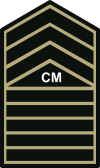 |
 |
| Senior Master Sergeant |  |
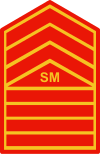 |
| Master Sergeant |  |
 |
| Technical Sergeant |  |
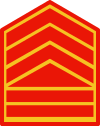 |
| Staff Sergeant | 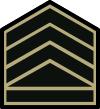 |
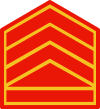 |
| Sergeant |  |
 |
| Corporal |  |
 |
| Private First Class |  |
 |
| Private | ||
Air Force
Until the early years of the 21st century the Air Forces sported the same enlisted insignia as the other services, its current enlisted rank insignia mirrors that of the United States Air Force, with the use of the national diamond roundel.
| Air force ranks | Battledress collar insignia | Service dress sleeve insignia | Full dress sleeve insignia |
|---|---|---|---|
| First Chief Master Sergeant | |||
| Chief Master Sergeant | 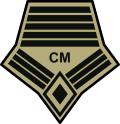 |
 |
 |
| Senior Master Sergeant |  |
 |
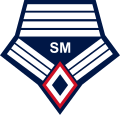 |
| Master Sergeant |  |
 |
 |
| Technical Sergeant |  |
 |
 |
| Staff Sergeant |  |
 |
 |
| Sergeant |  |
 |
 |
| Airman First Class |  |
 |
 |
| Airman Second Class |  |
 |
 |
| Airman Recruit |  |
 |
 |
Navy
| Naval enlisted ratings | Collar insignia | Sleeve insignia | Shoulder insignia (for senior rank holders only) |
|---|---|---|---|
| First Master Chief Petty Officer | |||
| Master Chief Petty Officer |  |
||
| Senior Chief Petty Officer |  |
||
| Chief Petty Officer |  |
||
| Petty officer, first class |  |
All petty officers and seamen of the Navy sport NO shoulder insignia. | |
| Petty officer, second class |  | ||
| Petty officer, third class |  | ||
| Seaman First Class |  | ||
| Seaman Second Class |  | ||
| Apprentice Seaman | |||
Five Star General/Admiral
President Ferdinand Marcos, who acted also as national defense secretary (from 1965–1967 and 1971–1972), issued an order conferring the five-star general/admiral rank to the President of the Philippines, making himself as its first rank holder. Since then, the rank of five-star general/admiral became an honorary rank of the commander-in-chief of the armed forces whenever a new president assumes office for a six-year term thus, making the President the most senior military official.[1]
The only career military officer who reached the rank of five-star general/admiral is President Fidel V. Ramos (USMA 1950) (president from 1992–1998) who rose from second lieutenant up to commander-in-chief of the armed forces.[2]
General of the Army Douglas MacArthur was also made a Field Marshal of the Philippine Army with five-star rank in 1938, the only person to hold that rank. Emilio Aguinaldo, the first President of the Philippines, holds an equivalent of five-star general under the title Generalissimo and Minister/Field Marshal as the first Commander-in-Chief of the AFP.
The position is honorary and may be granted to any military officer, especially generals/admirals who had significant contributions and showed heroism, only in times of war and national defense concerns and emergencies. Highest peace-time rank will be that of a four-star general which is being held only by the AFP Chief of Staff. However, no law specifically establishes the rank of 5-star general in the Armed Forces of the Philippines unlike in the United States and other countries.
See also
References
- ↑ Ferdinand E. Marcos at the Wayback Machine (archived August 4, 2008), Malacañang Museum.
- ↑ Fidel V. Ramos at the Wayback Machine (archived April 30, 2008), Malacañang Museum.